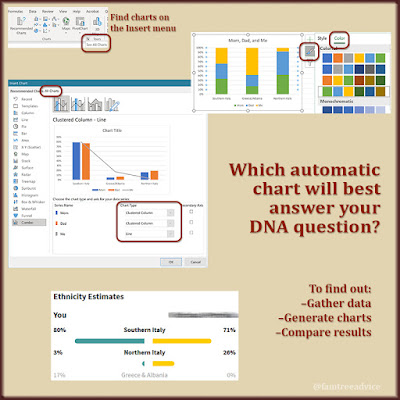Working on your family tree gets more exciting each time you discover something new. Maybe you discovered your great grandfather's brother and followed his paper trail. Maybe you went off on interesting tangents and built out several branches. Once your new discoveries run their course, you may find your family tree is a lot bigger.
How do you get back on track? How can you make sure you collect every available document for everyone in your family tree?
For me, the answer is simple. My document tracker is a 4,870-line spreadsheet that shows each document I've added to my family tree. It lists people from my tree in alphabetical order—but only people for whom I have documents. (Download a document tracker file you can use for yourself.)
| This inventory of which genealogy documents you have and which you need will help you make your family tree more complete. (Never finished, but more complete.) |
Most of my documents are very old Italian vital records. I do something special for those lines in the document tracker.
- If I've added all available documents for a person to my tree (birth, marriage(s), and death), I color their line green. That tells me that person is complete.
- In a completed person's "Need to find" column, I enter n/a for not applicable.
- If I can't get one or more of a person's vital records because they aren't online, I color their line blue.
- In an incomplete person's "Need to find" column, I enter what is missing, like this:
- out of range: birth
- out of range: marriage
- out of range: death
Here's a 40-second video (no sound) showing the process above.
Lately I've been working to make my collection of Italian vital records searchable. Since they are searchable, I should be able to complete all my Italians' "Need to find" columns.
This is such a fulfilling task! The documents are waiting for me to get them and add them to my family tree. So why wouldn't I chase them down?
I started at the top of my document tracker, but for now, I'm focusing only on those Italian documents. I'll skip over all the people with U.S. or other documents.
One at a time, I search my computer (using a free PC program called Everything) for a person. The document tracker tells me which documents I'm missing. Now I can definitively say if a person was born, married, or died "out of range" of the online documents. And if I find a missing document, I crop it in Photoshop and add it to both my family tree and my document tracker. I also create a source citation for each fact I learn from each document.
So many lines are now colored either green for complete or blue for out of range. Some day, if I gain access to church records, I may find many of the out of range documents. My document tracker will make it easy to see which church records I want.
This level of completeness makes me really happy. I always have a bunch of genealogy projects going on at the same time. One involves identifying all my relatives from one town, Santa Paolina, Avellino, Italy. For that fast-paced project, I'm adding facts only, not documents or citations. Not yet.
 |
| Diego was born out of range of available genealogy documents, but I know I found all that's available. |
Right now I want to work through my document tracker, filling in the blanks. Then I'll start adding documents and sources for my Santa Paolina people.
In my first two days of finding missing documents, I added 75 document images to my family tree. Unfortunately, there is a problem with Ancestry.com right now. No one can synchronize their Family Tree Maker file with Ancestry. I don't want to add tons of facts and documents until I get synchronized again. But I can collect and crop the images I need, and save them to add to my tree later.
If your family tree isn't too big, you can go person-by-person and see what you're missing. You may even want to create and fill in your document tracker at the same time.
My family tree has more than 30,500 people right now. I'm so glad I created my document tracker when I had less than 1,000 people. If your tree is too big to consider doing a person-by-person check, keep things close to you. Examine only your direct ancestors to see what's missing. Then branch out to the siblings of your direct ancestors.
Also, each time you view a person in your tree, for whatever reason, take note of what they're missing. As long as you're working on them, you may as well go all the way and search for everything you need.
Yes, those genealogy tangents are fun! But don't forget to double back and fill in the blanks for a more complete family tree.





